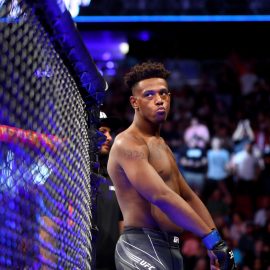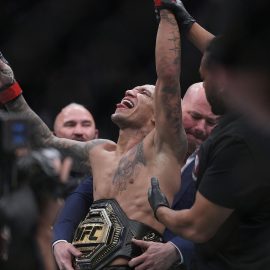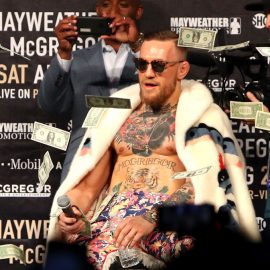Organic Chemistry
If you’re reading this, chances are you are a fan of mixed martial arts (MMA). Being a “fan” would then naturally lead to the assumption that you have a passion, a love, a bond with the sport. But why do you love it? What is it about violence between humans that captures your immediate interest?
We learn more about ourselves by studying the science into what makes us. In organic chemistry, atoms bond with each other chemically for a number of reasons, such as sharing electrons (covalent bonds). These bonding pairs have a lasting attraction to one another because the sharing of electrons allows them to secure a full outer shell, which creates stability. It completes them. And in a lot of ways, this observation of nature could, at the very least, serve as a metaphor for human attraction on an emotional level. We naturally gravitate to things we need, because we feel they complete us.
However, even on an atomic scale, bonds sometimes aren’t meant to last forever. Every now and then, two bonded atoms separate from each other, and either both atoms take exactly half of the shared electrons, or one of them takes more shared electrons than the other atom. In every day human life, this process sounds like a dead ringer for divorce. But in the science of organic chemistry, this is what we call a polar reaction.
Bellator 145: The Beginning of the End
It was November 6, 2015, the night of Bellator 145, which featured an exciting contest between featherweights Patricio Freire and Daniel Straus for the promotion’s featherweight championship. A bout between two of the best featherweight mixed martial artists in the world: an example of what the “hardcore” fan (aka: the MMA “purist”) is attracted to completely. Between the fight’s fast pace, Straus’S vicious ground-and-pound, and Freire’s resiliency to survive, the fight represented what hardcores love about the sport of MMA: two high-skill fighters using advanced techniques to best one another in a thrilling competition.
Earlier in the evening, professional wrestler Kurt Angle came out on stage, in what most insiders would’ve assumed was an announcement that the Olympic Gold Medalist was going to make his long-rumored MMA debut. Though, a 46-year-old pro wrestler (who is battle-torn with a slew of serious injuries) fighting in their sport is not what hardcores typically gravitate towards, they have learned to take bookings like these with a grain of salt, hoping it would be a one-off attraction just to create some temporary buzz before the stability of seeing Freire-Straus-like contests would take them back to what they love about MMA; similar to when the UFC brought in boxer James Toney for a single-event contest against MMA legend Randy Couture, who submitted Toney in short order for him to never be heard of again in MMA circles.
However, Angle didn’t announce his MMA debut. He instead announced that after nearly twenty-one years, 52-year-old Ken Shamrock and 49-year-old Royce Gracie would complete their trilogy at Bellator 149 on February 19, 2016, and end a rivalry that began at the first UFC event on November 12, 1993.
What could only be accurately described as a “seniors bout” wasn’t the type of contest the hardcores were usually too interested in. But between the legendary status the two fighters had, the relative age (and thus, an even contest) between them, the amount of buzz it would generate among the “casual” audience (who typically come around to MMA when big names are involved), the hardcores mildly forgave the booking.
When it was also announced that street fighters Kevin “Kimbo Slice” Ferguson and Dhafir “Dada 5000” Harris would also square off in the co-main event of Bellator 149, the reaction from the hardcore audience was a similar “oh, you…” to Bellator for booking what is commonly known as a “freakshow” bout between two non-elite fighters whose popularity comes mainly from outside of the MMA world.
But to the hardcores, like Shamrock-Gracie, at least Ferguson and Harris were evenly matched. And this event headlined by a seniors bout and a freakshow bout was just a one-off attraction. What could possibly have gone wrong?
Hardcores and Casuals
The bond that the hardcore audience have with MMA is a strong one. The hardcores will study fights on a deeper level, they’ll memorize more about fighters, more about fighting styles, who those fighters train with, the gyms they train at, and how their gym typically performs. They’ll remember a large quantity of MMA events and results, and they’ll process how fighters will match up against each other based on a number of factors, including: skill, size, training partners, gyms, past performances, dehydration levels, drug usage/non-usage, lifestyle, etc.
They’ll share their thoughts with other like-minded hardcore fans on message boards and social media, and some might join a local gym to understand techniques better and join the martial arts lifestyle.
Hardcore fans love the sport, and their love is a pure one: completely unmotivated by money or personal gain. They love MMA because they need it. It completes them.
The casual audience typically does not love MMA on this level. The casual audience has a passing intrigue, and are most interested in seeing recognizable names compete. Their interest is more motivated by wanting to be slightly aware of relevant names and topics in the sport for occasional entertainment value and to be “current” on a fringe sport like MMA, so they have something to talk about by the water cooler on a Monday morning at work.
Though, by this criteria, the casual audience should be considered the least important audience to cater to, they are in fact the most important audience there is in MMA. Why? Because they’re larger in quantity than the hardcores.
Ronda Rousey’s explosion of popularity was completely dependent on casual interest, based heavily on being marketed as a female Mike Tyson-like destroyer who was paving the way for women’s equality in sports: a perfect tie-in to the topical boom of feminism, and becoming a Hollywood superstar while doing it. Conor McGregor’s popularity can likewise be chalked up to the casual audience, who are more captivated by trash-talking and visual flamboyancy than they are by picture-perfect striking combinations, well-executed double-leg takedowns, and pivotal guard passes.
To the brass who run MMA, quantity represents more eyeballs. The casual audience will make the difference on if a UFC event will do over 1,000,000 pay-per-view (PPV) buys like a Ronda Rousey-headlined event, or 115,000 PPV buys like a Demetrious Johnson-headlined event, which would appeal only to the hardcores. The casual audience made Floyd Mayweather-Manny Pacquiao one of the biggest sporting events of all time, and they continue to represent the desired demographic to target in combat sports if an organization wants to achieve large numbers, and make the most money possible.
The hardcores and the casuals represent the two polar opposite demographics that MMA promoters are tasked with appeasing. And on February 19, 2016, Bellator went all-in on catering directly to the casual audience.
Bellator 149: An Event That Will Live In Infamy
Notwithstanding having a possibly drunk (or otherwise) Mike Tyson on commentary for a slugfest between lightweights Derek Campos and Melvin Guillard (which was entertaining nonetheless), Bellator 149 went without a hitch up until the co-main event.
With a heavy emphasis on video packages, set design, and lighting, it was clear that this higher-budget Bellator event was designed specifically for the casual audience who usually need the bells and whistles of loud production values much more than the hardcores do.
What was expected to be a very quick, one-minute-or-so affair between heavyweight street fighters Ferguson and Harris ended up being one of the most infamous bouts in MMA history. Evident that both fighters had exhausted themselves only minutes into the fight, and as a result, both losing the power required to score a knockout (and both unsurprisingly lacking any submission skills), the bout dragged into train wreck territory with each passing minute.
Ferguson, upon expending his last energies after each combination attempt, would take Harris down, and quickly score a full mount (a usually difficult position to obtain, but not on Harris, who quite apparently had a nonexistent ground game) just to regenerate a small iota of energy.
Veteran referee John McCarthy, realizing that these were stall attempts, would make rare decisions to stand both fighters back up from the full mount position, only for Ferguson to repeat his strategy.
The fight ended in the third round, when the completely spent Ferguson landed one final combination, sending an even more exhausted Harris stumbling back halfway across the cage and collapsing more due to his fatigue than the combination itself, in what can only be called a “Flair flop.”
The casuals were amused by this spectacle of two low-skill brawlers fighting on a national stage on what would be more apropos for a bar room at 3:51 AM right before last call, evident by laughs and cheers coming from the audience after the finish, while the hardcores fumed over this “embarrassment” of MMA. This is not the MMA they loved, and represented the absolute worst the sport could offer; and on national television, no less—which made the hardcore audience all-the-more furious at Bellator for letting this mockery happen.
And the worst part for the hardcores? The night wasn’t even over yet.
We Come From The Old School
In the main event, Shamrock and Gracie both received VIP treatment in well-produced entrances that built both as major stars, which came off impressively to most in the arena and at home, but peeved some hardcores that Bellator usually spares their actual elite talent (like Will Brooks or Marcus Galvao) this same extravagant presentation.
What started off as a tentative bout between the two pioneers filled mostly with Gracie throwing non-connecting kicks to presumably keep Shamrock (who many expected to outstrike the grappler Gracie) at bay, culminated in a clinch where Gracie seemingly threw an illegal knee to Shamrock’s groin, which the referee Jacob Montalvo happened to miss entirely despite being in relatively visible position, that Shamrock did not sell. Gracie followed up with another knee to Shamrock’s head, which saw Shamrock fall holding his groin, leaving him open for undefended hammerfists from Gracie, prompting Montalvo step in and stop the fight midway into the first round.
Shamrock immediately snapped at Montalvo with the same anger he has become synonymous with, identical to when he contested his protégé Guy Mezger’s draw with Kazushi Sakuraba in PRIDE FC some sixteen years earlier (Mezger having reunited with Shamrock for this fight against Gracie).
Meanwhile, Gracie happily celebrated as if nothing was wrong, while Shamrock proceeded to stalk Gracie, yelling that he threw a groin shot on purpose. An initial replay only showed the knee to the head, prompting Bellator commentator Jimmy Smith to question Shamrock’s validity of his claim that he suffered a low blow. However, another replay clearly showed the illegal strike to the groin, in which Smith quickly apologized to Shamrock, and acknowledged the fact that Gracie won the fight under false pretenses.
The finish has led to a number of questions. Why didn’t Shamrock immediately contest the low blow?
The most popular theory (which was suggested on commentary) was that it was simply a delayed reaction, which is very real possibility. A more jaded suggestion is that the low blow wasn’t that severe (or at least Shamrock didn’t think it was to immediately contest it), and then got legitimately knocked down with Gracie’s follow-up knee to the head, which saw him get TKO’d fairly, and he only then decided to contest the low blow to create a disputed finish and set up an eventual rematch (not unlike his second bout with Tito Ortiz): simply an expert on-the-spot tactic by a former professional wrestler to secure another paycheck.
Shamrock eventually settled down, and in a class maneuver, apologized to Gracie for losing his temper. Gracie followed up by stating that the final chapter was closed.
The hardcores responded by calling the event the worst in MMA history.
That Joke Isn’t Funny Anymore
Sure enough, Shamrock has filed a complaint with the Texas Department of Licensing and Regulation. He’s calling for the fight to be overturned to a no-contest, and an immediate rematch which should be considered the third and final fight of their trilogy (and would actually be the fourth fight between Shamrock and Gracie).
However, what the hardcores considered the biggest joke of the card became very serious in the aftermath of Bellator 149.
As a result of a drastic forty-pound weight cut sustained over three months, Harris was rushed to the hospital immediately after his fight against Ferguson, and was in critical condition overnight. News circulated that his heart stopped, and that he “almost died.” Harris’s family released a statement which mentioned his weight cut, and noted that “extremely high levels of potassium in his blood” was the cause of renal failure, fatigue, and dehydration.
A death in the cage is the biggest fear for an MMA organization, and if what was reported is true, then Bellator narrowly dodged a bullet. More so considering the nature of these bookings were questionable to begin with, and the amount of scrutiny in a nightmare scenario such as a death would’ve led to extreme scrutiny on not just Bellator, but its parent company Viacom; which, as a publicly-traded company, could not have afforded to be associated with a controversy of that nature—especially on a tiny expendable cog like Bellator in the enormous important wheel that makes up Viacom.
Harris’s potential death would’ve possibly led to the end of Bellator, and would’ve caused irreparable damage to MMA’s already struggling reputation as a mainstream sport—with the UFC suffering collateral damage despite no association with the event.
On top of their prior condemnation of the event, the news of Harris’s very real struggle for his life received mixed reaction from the hardcores: ranging from more anger towards Bellator, to disrespectful remarks against Harris directly. UFC commentator Joe Rogan joked that Harris’s heart was “filled with cheeseburgers and fried chicken and orange soda,” which Harris’s family responded by calling racist and offensive.
Fighters Pat Barry and Rose Namajunas took a classier approach, and commended both Harris and Ferguson for their incredible display of heart and showmanship despite both being exhausted early in.
Hardcores nonetheless nearly unanimously agreed that the event was a flop, critically. But to Bellator, the show was never for the hardcores to begin with.
Bellator 149 was a gigantic success, and it was because the casuals made it so. The show averaged nearly two million viewers throughout the broadcast, breaking the previous record (set last year by another freakshow attraction in Shamrock-Ferguson). The casuals were intrigued enough by fights between fifty-year-old pioneers and street fighters to make it the most-watched Bellator show in history.
Completion
The hardcores labeled Bellator 149 a failure, critically. The casuals made Bellator 149 a success, commercially. A polar reaction from two opposite demographics: a problem which exists, always has existed, and always will exist in the sport of MMA. The solution to this separation of ideologies is compromise.
Though the hardcores are adamant Bellator 149 should put an end to their “freakshow experiment,” or else they will boycott future shows, the ratings dictate that Bellator is on the right track for achieving growth in their business—growth that they didn’t attain when marketing directly to hardcores with far superior technical match-ups like Freire-Straus.
Hardcores want elite competitors fighting to achieve superiority. Casuals want recognizable names fighting to settle grudges. There’s a brand of violence suited for each demographic, and it’s natural for a consumer to gravitate towards the type of MMA they want to see, just like how an atom bonds with another atom to share the electrons they need.
With the quantity of shows that a promotion like Bellator has, there’s no doubt that they have a strategy which will cater certain shows for the hardcores, and other events for the casuals. This is the compromise needed. This is the compromise that gives Bellator its own unique identifier—doing things the UFC is not doing—like co-promoting with other organizations, or starting their own kickboxing league. Bellator will not flourish by being UFC lite: a brand of MMA strictly to cater to a demographic which the UFC already has a predominant grasp over.
Though an event like Bellator 149 causes a polar reaction in the sport of MMA, this also results in a much desired effect. As a result of their reaction to this event, hardcores might be more appreciative towards Bellator’s future offering of Michael Chandler-Josh Thomson, which looks far more attractive when juxtaposed to Ferguson-Harris.
Casuals might have been completely satisfied with Bellator 149, and may be looking forward to a potential Royce Gracie-Kimbo Slice fight.
The effect caused by the polar reaction of Bellator 149 results in every MMA viewer, whether hardcore or casual, to find themselves more attracted to the MMA they need. It completes them.
Add The Sports Daily to your Google News Feed!







